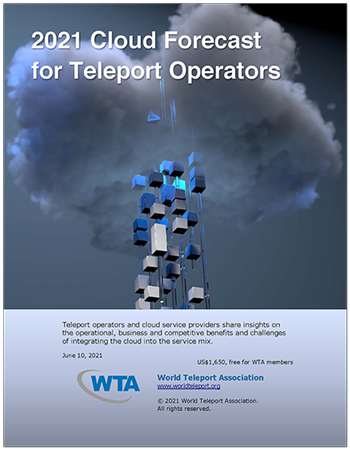Satellite operator SES recently announced that it was seeing strong uptake for its Cloud Playout service, as customers embraced it for management and playout of linear TV channels over satellite. Creating the service was a shrewd move for a satellite operator that generates 60% of total sales from its video business. After initial resistance, US and European broadcasters have been shifting media management and playout to the cloud to take advantage of its robust content management and scheduling applications and the scalability of the cloud. In its press release, SES cited an Ethiopian broadcaster, which suggested that the customer uniquely trusted SES to successfully guide its entry into cloud processing.
When clouds appear in the sky, it’s no surprise. When they appear on the ground, it’s fog. The situation with teleport service providers adopting cloud technology so far remains a bit foggy.
Adopting at their Own Pace
 Over the summer, WTA published a report, 2021 Cloud Forecast for Teleport Operators, which updated a 2018 report on the same topic. With 92% of enterprises running at least a portion of their computing in the cloud today, we wanted to see how far along the sector was in putting the cloud to work for customers.
Over the summer, WTA published a report, 2021 Cloud Forecast for Teleport Operators, which updated a 2018 report on the same topic. With 92% of enterprises running at least a portion of their computing in the cloud today, we wanted to see how far along the sector was in putting the cloud to work for customers.
In 2018, teleport operators were moving slower than the business world in general, eying the trade-offs between flexibility and risk reduction on the one hand and the potential for greater profit and greater control from running a service on their own infra¬structure on the other. Another reason for the reluctance to move to the cloud was the time, effort and cost of upgrading legacy systems to run in a virtualized environment. Most were only taking cautious steps towards integrating their systems and services into public clouds. One of the operators commented at the time: “I think cloud services are never going to be a growth engine for us.”
Today, operators are unanimous in expecting their use of the cloud to grow significantly, though the pace of actual adoption varies widely. For many, it is a matter of surrendering to the inevitable. Others see it as the key to future growth. One large service provider with a lot of broadcast clients commented that: “In general the broadcast sector is the most advanced. Media supply chains have been migrating to the cloud for the last five years, with many channels of linear playout being originated from the cloud now.” Echoing that sentiment, another large player that considers itself a leader in cloud adoption commented: “We have many cloud projects on both the infrastructure and service layers. Some of them are already in production and used by our customers, such as live4K playout and digital cinema delivery, and all of our projects are now fully oriented towards cloud-based infrastructure.”
On the other hand, a smaller regional operator serving media customers said: “At the moment we rarely encounter them asking for cloud, they just want the service (playout and time delay) and don’t mind how it is delivered.”
Two of the regional operators, both with a variety of customers, identified retail as the one of the most advanced sectors. “Supermarket chains seem to be ahead of the game,” one of those operators said. “They operate on a low margin, so they have been an early adopter and are continuing to adopt at a faster rate than other sectors.” Respondents also identified another low-margin, high volume business, retail gas stations, as among the most advanced.
It’s About the Skills
What determines how ready teleport operators are to adopt public cloud services? Sunk costs in existing technology are certainly a factor. Executives told us that they expect adoption to accelerate as existing equipment comes up for replacement. Security is an issue for operators as well as some customers, despite the fact that cloud services have proven far more secure than in-house IT operations. Perceptions aside, there can be security risks when it comes to ingress and egress to the cloud over the public internet. That risk is eliminated when service providers gain a “direct connect” relationship with the cloud operator, which enables a private fiber link from server to server.
But such practical considerations may not be the most important. One service provider suggested it was more about the installed base of people than equipment. “The degree of advancement depends on the teams that the operator has in place,” he said. “Some are more experienced, particularly the younger ones; the older aerospace guys with a ton of experience don’t get the cloud. On the other hand, if the staff are too young, they don’t get space.” He went on to add: “Furthermore, some companies are just too small. They lack the resources to implement the move to the cloud.”
Some new entrants in the ground-segment-as-a-service space have built their management applications in the cloud from the beginning, and they are very satisfied with the flexibility, security, resilience and reliability of the platforms. As one executive put it, “We’ve integrated many customers through our cloud platform already. AWS is designed for this. It lets customers launch their own appli¬cations and lets us get the data to their applications.”
Size Matters
For others, size of company does seem to matter. A few midsize regional operators have found both success and difficulties in the cloud. One executive described deploying Office 365 and MS Teams for a few customers and finding it a challenge. “It’s not an easy journey,” the operator said. “There are some complex elements that have to be factored in. Particularly in some parts of the world, there are a lot of sensitivities around moving to the cloud, including security and staffing levels.”
Another regional operator that is offering third-party applications in the cloud sees this as a competitive advantage, saying: “It gives us an edge in the capability portfolio. Offering third-party applications is a way of main¬taining revenue in a commoditized market. Connectivity as a service has become a commodity business, meaning that price points are declining. Even if the volume increases, revenue is flat, so it is important to move to where you can add value to grow wallet share.”
Bigger companies with global operations, however, find it most affordable and have the IT skills in-house to make it happen. One of them has moved all its specialized customer applications for BSS and OSS into the cloud. “For the customer, it is transparent,” the operator said. “Either they have access to a portal or to a set of APIs which are customized to the services that we deliver. This approach has been in use for 10-15 years. Before, the services were on servers in our premises. Now they are in the cloud. It makes no difference to the customer.”
Two other global operators were well advanced on the cloud journey. One of them stated that it was the company strategy to move everything towards cloud applications. “Most corporate applications are on Azure, and we use the Microsoft Office Suite for most employee interactions. This not only reduces the effort required to manage things, it also minimizes issues with our Virtual Private Network (VPN) access.” The other international operator was also heavily invested in cloud applications, saying: “We have replaced almost all internally based systems with managed cloud services. These services are meeting the critical company needs around the security of our corporate, customer and asset data.” An additional benefit of using the cloud for corporate applications is the ease with which new applications can be integrated with existing business systems.
For another large operator, integrating services into the cloud has become second nature. “We are internally developing services that are fully inte¬grated into the cloud, being agnostic as to which cloud provider.” This operator has designed a full cloud service for delivery of digital cinema package (DCP) to theaters, playout for linear channels and video-on-demand as well as a full live video transport solution over the cloud for delivering content contribution all over the world.
Follow the Snowball
“Like a giant snowball continuing to roll and growing larger every minute.” That’s how one regional operator described the move to the cloud. There are many reasons that operators and service providers see cloud usage growing. Bowing to the inevitable is one. As more and more business moves to the cloud, service providers who don’t offer a cloud solution will find themselves losing customers.
But those who have put a toe in the water do find positive reasons to go deeper. Savings on energy costs and the capital expense of full redundancy for the data center are attractive. “When we use the cloud, we don’t need all the power-hungry equipment onsite,” said the operator. “We can get by with a smaller gener¬ator and smaller UPS, so the energy costs come down. Furthermore, moving to the cloud means we benefit from the built-in redundancy and get more flexibility as well.”
For operators of all sizes, being in the cloud makes it easier to expand. As systems grow and new customers come online, there is no need for capital expenditure to purchase additional equipment, and customers can be added with minimum effort. One teleport customer, a consumer service, went from a few users to over one million overnight.
Increasingly, the cloud is being seen as a key enabler for growth. One company has set a goal of putting “a lot more of our business into the cloud, whether that be public or a private one that we create ourselves.” Another operator already has 20% of its business in a virtualized private cloud in its teleport, and is planning on moving that business to a fully secured public cloud. As one of the service providers said: “The cloud is the key to our global strategy.”
-------------------------------------
 Robert Bell is Executive Director of the World Teleport Association, which represents the world’s most innovative teleport operators, carriers and technology providers in 46 nations. He can be reached at rbell@worldteleport.org
Robert Bell is Executive Director of the World Teleport Association, which represents the world’s most innovative teleport operators, carriers and technology providers in 46 nations. He can be reached at rbell@worldteleport.org
The 2021 Cloud Forecast for Teleport Operators is available for free to members and for sale to non-members at https://www.worldteleport.org/store/viewproduct.aspx?id=18497754. A webinar based on the report, “Delivering Hybrid Cloud Services,” is available free on de





